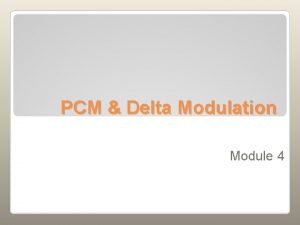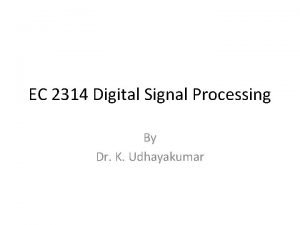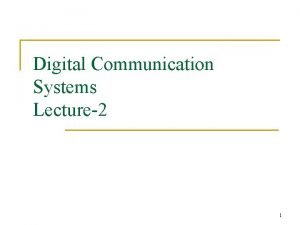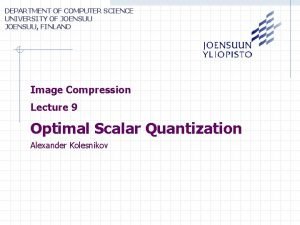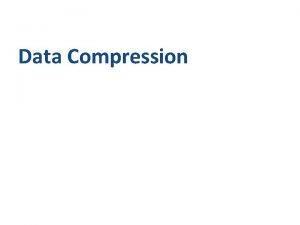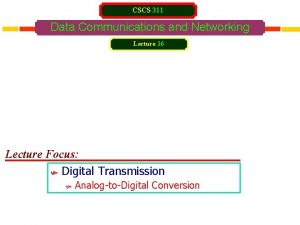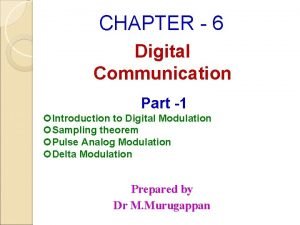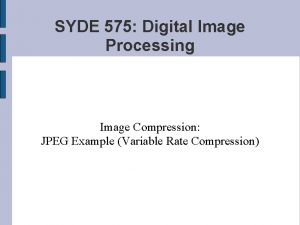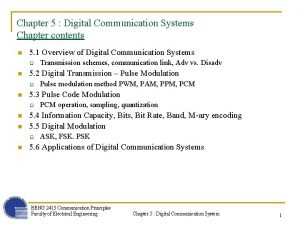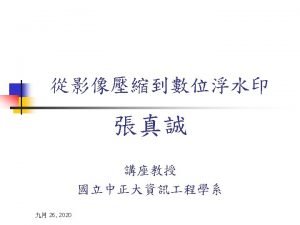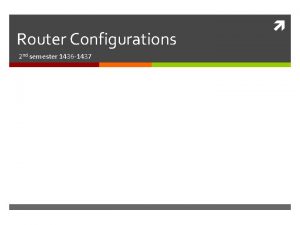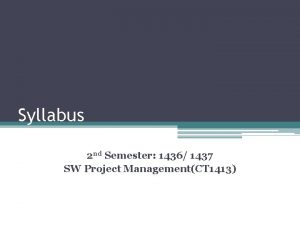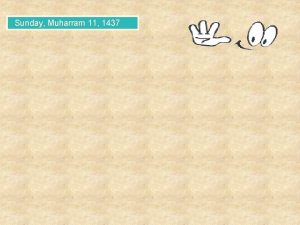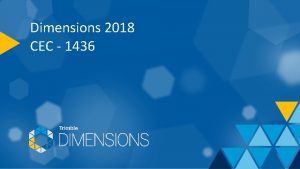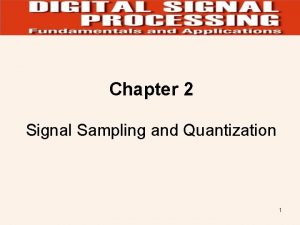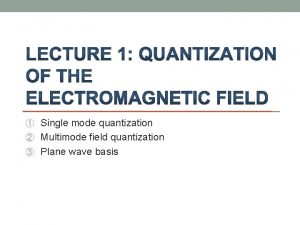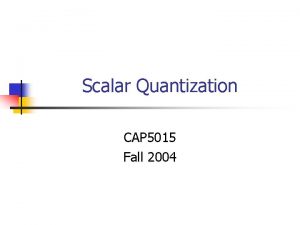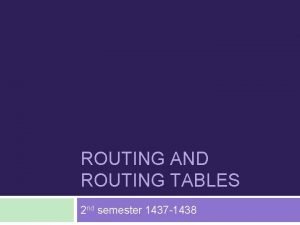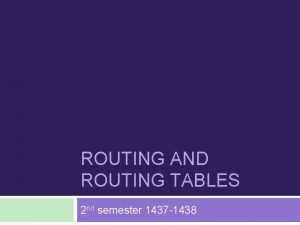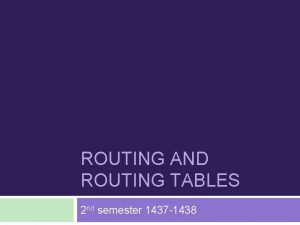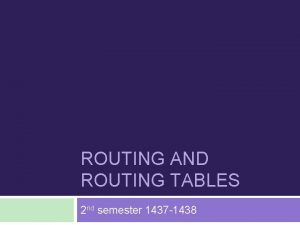Sampling and Quantization 2 nd semester 1436 1437


























- Slides: 26

Sampling and Quantization 2 nd semester 1436 / 1437

Introduction �A digital signal is superior to an analog signal because it is more robust to noise and can easily be recovered, corrected and amplified. �For this reason, the tendency today is to change an analog signal to digital data

Introduction �An analog signal: amplitude can take any value over a continuous range. �Digital signals: amplitude can take only discrete and finite values. Can we convert an analog signal to a digital signal

Changing analog signal to digital signal: Sampling Quantizing Coding

Introduction �One can convert an analog signal to a digital signal by sampling and quantizing (collectively called analog-todigital conversion, or ADC). �The processed signals are then converted back into analog signals using a reconstruction or interpolation operation (called digital-to-analog conversion, or DAC).

Sampling

Sampling Process �The sampling process is a basic operation in the digital communication. �In this process, the continuous-time analog signal is sampled by measuring its amplitude at a discrete instants. �So, the continuous-time analog signal is converted into a corresponding sequence of samples that are usually spaced uniformly in time. �It is necessary to choose the sampling rate properly, so the sequence of samples uniquely defines the original analog signal.

Sampling �To sample a continuous-time signal x(t) is to represent x(t) at a discrete number of points, t = n. Ts , where Ts is the sampling period.

Sampling Theorem �The sampling theorem states that a band-limited signal x(t) with a bandwidth W ( W is the highest frequency) can be reconstructed from its sample values if the sampling rate (frequency) fs =1/Ts is greater than or equal to twice the bandwidth W of x(t) �The minimum sampling rate of fs for an analog bandlimited signal is called the Nyquist rate.

Sampling �There are 3 sampling methods: �Ideal - an impulse at each sampling instant �Natural - a pulse of short width with varying amplitude �Flattop - sample and hold, like natural but with single amplitude value

Sampling �As long as the sampling of the analog signal is taken with a sufficiently high frequency (higher than the minimum Nyquist rate of twice the signal largest frequency), it can be shown that there is no loss in information as a result of taking discrete samples.

Quantizati on

Quantization �In order to process the sampled signal digitally, the sample values have to be quantized to a finite number of levels, and each value can then be represented by a string of bits. �To quantize a sample value is to round it to the nearest point among a finite set of permissible values. �Therefore, a distortion will inevitably occur. This is called quantization noise (or error).


Quantization �The sampling results is a series of pulses of varying amplitude values ranging between two limits: a min and a max. �The amplitude values are infinite between the two limits. �We need to map the infinite amplitude values onto a finite set of known values. �This is achieved by dividing the distance between min and max into L zones, each of height = (max - min)/L

Quantization Levels �The midpoint of each zone is assigned a value from 0 to L-1 (resulting in L values) �Each sample falling in a zone is then approximated to the value of the midpoint.

Quantization Zones �Assume we have a voltage signal with amplitutes Vmin=-20 V and Vmax=+20 V. �We want to use L=8 quantization levels. �Zone width = (20 - -20)/8 = 5 �The 8 zones are: -20 to -15, -15 to -10, -10 to -5, -5 to 0, 0 to +5, +5 to +10, +10 to +15, +15 to +20 �The midpoints are: -17. 5, -12. 5, -7. 5, -2. 5, 7. 5, 12. 5, 17. 5

Quantization Error �When a signal is quantized, we introduce an error - the coded signal is an approximation of the actual amplitude value. �The difference between actual and midpoint value is referred to as the quantization error. �The more zones, the smaller which results in smaller errors.

Coding

Encoding �In combining the process of sampling and quantization, the specification of the continuous-time analog signal becomes limited to a discrete set of values. �Representing each of this discrete set of values as a code called encoding process. �Code consists of a number of code elements called symbols. �In binary coding, the symbol take one of two distinct values. in ternary coding the symbol may be one of three distinct values and so on for the other codes.

Assigning Codes to Zones �Each zone is assigned a binary code. �The binary code consists of bits. �The number of bits required to encode the zones, or the number of bits per sample, is obtained as follows: nb = log 2 L �Given our example, nb = 3 �The 8 zone (or level) codes are therefore: 000, 001, 010, 011, 100, 101, 110, and 111 �Assigning codes to zones: � 000 will refer to zone -20 to -15 � 001 to zone -15 to -10, etc.

Line Coding �Any of several line codes can be used for the electrical representation of a binary data stream. �Examples of line coding : RZ, NRZ, and Manchester

10 x(t) 2 Consider the analog Signal x(t). t X(n. Ts) 10 Ts 2 n The signal is first sampled

10 8 6 4 2 2 dividing the range into 4 zones n 3 2 1 0 assign quantized values of 0 to 3 to the midpoint of each zone. n

3 2 1 0 approximating the value of the sample amplitude to the quantized values. 11 n 3 10 2 01 1 00 0 Each zone is assigned a binary code n

11 3 10 2 01 1 00 0 01 11 11 11 01 00 00 The sequence bits if the samples 01111111010000 Use one of the line code scheme to get the digital signal n
 Dhany arifianto
Dhany arifianto A consumer confidence researcher asks several retailers
A consumer confidence researcher asks several retailers Advantages and disadvantages of sample survey
Advantages and disadvantages of sample survey Cluster v stratified sampling
Cluster v stratified sampling Perbedaan time sampling dan event sampling
Perbedaan time sampling dan event sampling Cluster random sampling vs stratified
Cluster random sampling vs stratified Sampling frame definition in research
Sampling frame definition in research Natural sampling vs flat top sampling
Natural sampling vs flat top sampling Scalar and vector quantization
Scalar and vector quantization Quantization of charge
Quantization of charge Calculate quantization error
Calculate quantization error Quantization of energy
Quantization of energy Digital signal processing
Digital signal processing Digital transmission advantages and disadvantages
Digital transmission advantages and disadvantages Quantization error formula
Quantization error formula Calculate quantization error
Calculate quantization error Image compression
Image compression Calculate quantization error
Calculate quantization error Quantization definition in digital communication
Quantization definition in digital communication Companding in pcm
Companding in pcm Vector quantization
Vector quantization Vibration of crystals with monatomic basis
Vibration of crystals with monatomic basis Quantization of electric field
Quantization of electric field Quantization matrix
Quantization matrix Quantization
Quantization Quantization in digital communication
Quantization in digital communication Quantization
Quantization










